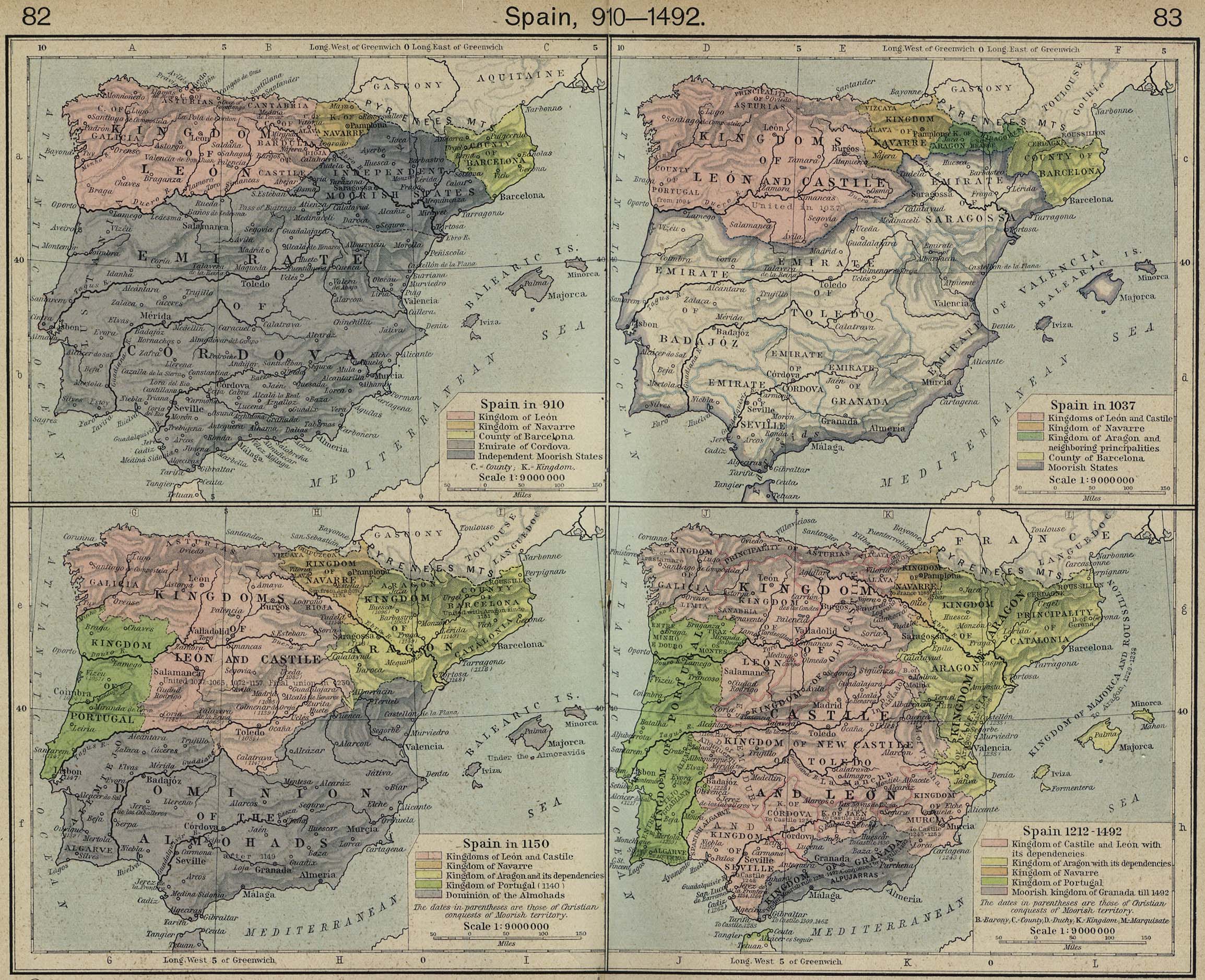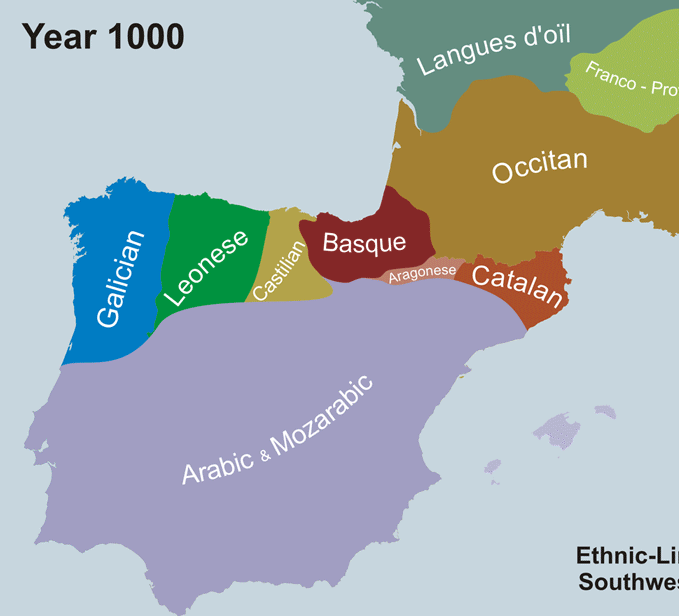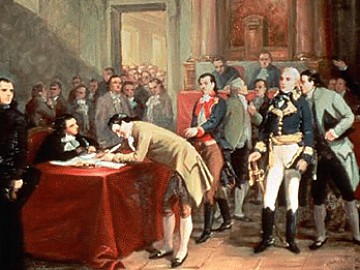For many years the Spanish monarchy and the dictatorships which followed (Primo de Rivera and Franco) maintained the position that Spain was a unified nation, the legacy of the Roman province, Hispania. In reality, Spain is and has long been quite divided. Currently, Spain is divided into eighteen regions, which are themselves composed of fifty provinces.
The most relevant part of Spain's early history is that the whole Iberian Peninsula became part of the Roman Empire. The Romans, who divided the peninsula into different provinces, introduced the Latin language, Roman law, and Christianity to the majority of the peninsula, were succeeded by a couple different Germanic tribes. The most significant of these was the Visigoths, who attempted to unify the disparate parts of Iberia, focusing on the Roman legacy, especially the Roman law. 711AD marks the beginning of the Moorish period. The vast majority of Iberia came under Islamic control fairly quickly, and gradually receded over time. Over the next couple hundred years, the rulers of Muslim Spain (that is, the still largely Christian part of the peninsula which had Muslim rulers), especially the Caliphate of Cordoba, were consolidating power and patronizing the arts and sciences, as well as experiencing relative religious tolerance. In the mountainous, rural northern regions to the north, the Christian rulers were regaining their footing, despite numerous internal conflicts. The next couple hundred years can largely be described as a period of intermittent aggression balanced with wary tolerance.
The Christian kingdoms gradually expanded at the expense of the Caliphate of Cordoba and sometimes of each other in a process known as the Reconquista. With the disintegration of the Caliphate into the “Taifa States,” the Christian kingdoms were able to more easily expand by means of shifting alliances. A couple of successive fundamentalist Islamic regimes (primarily the Almoravids followed by the Almohads) invaded from North Africa and imposed unity on the Taifa kingdoms at the expense of tolerance and intellectual livelihood. The thirteenth century saw a drastic expansion in which the Christian kingdoms approximately doubled their territory, leaving Granada as the only independent Muslim state, albeit a highly bullied one. That was finally conquered by the Kingdom of Castile in 1492. Just as Christians remained in Moorish Spain after that conquest, so too did Muslims and Moorish culture remains after the Christian conquest.


Spain was, and still is a diverse country integrated by different contrasting regions that show varying economic and social structures, as well as different languages and historical, political and cultural traditions. According to the Spanish constitution, the Spanish nation is the common and indivisible homeland of all Spaniards, which is integrated by nationalities and regions to which the constitution recognizes and guarantees the right to self-government.
The terms "nationalities" or "historical nationalities"(Spanish, Galician, Basque, Catalan) though never defined officially, are territories whose inhabitants have a strong historically constituted sense of identity, or more specifically, certain autonomous communities whose Statutes of autonomy—their basic institutional legislation—recognizes their historical and cultural identity.
The formation of Spain can be viewed as an alliance and progressive union of several peninsular kingdoms, and it can be said that the nationalist or regionalist tradition in Spain has its roots in Spanish history. In fact, no serious attempt was made to centralize the administration until the reforms of the eighteenth century. By the beginning of the nineteenth century, though, the Spanish government was heavily centralized and the State did not recognise the nation's regional diversity. It was also, later during this same century, that as Catalonia and the Basque Country became rapidly industrialised and areas where commercial capitalism made swift progress while the rest of the country followed at a much slower pace, nationalistic sentiments began to grow, and it was not unusual that some writers of the time would express their concepts of a Catalan or Basque fatherland or even nationhood.
Both nationalist movements had much in common, in that both arose in areas that enjoyed higher levels of prosperity and were the only areas in the country to develop modern industry, and both possessed a linguistic tradition of their own both the Catalan and the Basque languages began to experience a strong revival, as was the case with the Galician language. As nationalistic sentiments grew, sometimes within conservative ideals and afterwards with the left, their demands for self-government also grew, and in some sectors, separatism — outright independence — was preferred.
The appearance of the so-called peripheral nationalism in the aforementioned regions of Spain occurred in a time where Spain itself as a whole first began to look into its own concept of nationhood, and where Spaniards began to study their own nationalism between two competing views, the traditionalist, where religion played a significant role in defining the Spanish nation, intrinsically and traditionally Catholic, and strongly monarchical, and the liberal view where sovereignty resided in the nation — the people, as opposed to the monarch — and where some advocated for a uniform centralized State while others preferred decentralization and even republicanism.
 Spain experimented with decentralization during the First Spanish Republic (1873-1874), but social and political chaos, which had started even before the change of regime with a change of monarchical houses, led to its failure.
Spain experimented with decentralization during the First Spanish Republic (1873-1874), but social and political chaos, which had started even before the change of regime with a change of monarchical houses, led to its failure.
At the beginning of the twentieth century, the two political discourses of Spanish nationalism, the traditional and the liberal, continued to be present and opposing, advocating for different political regimes.
During the final stages of the 'turno pacífico', a staged pacific alternation of power between liberals and conservatives in the Spanish Parliament, Catalonia was granted a limited form of self-government, and the Commonwealth of Catalonia (Catalan: Mancomunitat de Catalunya) was established in 1913, with its own Regional Assembly. The Assembly drafted a Statute of Autonomy that was, however, rejected by the General Courts (the Spanish Parliament). The Commonwealth of Catalonia was dissolved during the dictatorship of Primo de Rivera (Marquis of Estella) in 1923. Primo de Rivera was a dictator, aristocrat, and military officer who served as Prime Minister of Spain from 1923 to 1930 during Spain's Restoration era. He deeply believed that it was the politicians who had ruined Spain and that governing without them he could restore the nation. His slogan was "Country, Religion, Monarchy." Historians depict him as an inept dictator who lacked clear ideas and political acumen, and who alienated his potential supporters such as the Army. He did not create a base of support among the voters and depended instead on elite elements. His actions discredited the king and ruined the monarchy, while heightening social tensions that led eventually, in 1936, to a full-scale Spanish Civil War.
 In 1931, the Second Spanish Republic was established, and a new liberal constitution allowed the "regions" of Spain to attain self-government and created the "autonomous region" as a first-order administrative division. Catalonia was the first to approve a Statute of Autonomy and the Generalitat, the Catalan institutions of government that operated since medieval times until the early eighteenth century, was restored. The Basque Country and Galicia followed suit in 1936, but only the Statute of Autonomy of the first was approved before the Spanish Civil War erupted.
In 1931, the Second Spanish Republic was established, and a new liberal constitution allowed the "regions" of Spain to attain self-government and created the "autonomous region" as a first-order administrative division. Catalonia was the first to approve a Statute of Autonomy and the Generalitat, the Catalan institutions of government that operated since medieval times until the early eighteenth century, was restored. The Basque Country and Galicia followed suit in 1936, but only the Statute of Autonomy of the first was approved before the Spanish Civil War erupted.
After the war, centralism was most forcefully enforced during Franco's regime (1939-1975) as a way to preserve the unity of the Spanish nation. His attempts to fight separatism with heavy-handed but sporadic repression and his oftentimes severe suppression of language and regional identities backfired: the demands for democracy became intertwined with demands for the recognition of a pluralistic vision of the Spanish nationhood. When Franco died, Spain entered into a phase of transition towards democracy, and all democratic groups were forced to face the Catalan, Basque and Galician question.
On 11 September 1977, more than one million people marched in the streets of Barcelona (Catalonia) demanding "llibertat, amnistia i estatut d'autonomia", "liberty, amnesty and Statute of Autonomy", the biggest demonstration in post-war Europe. A decree-law was passed that allowed for the creation of pre-autonomías, "pre-autonomies" or provisional regional governments for all regions, the "historical nationalities" included. Catalonia was the first to be so constituted, reviving again the Generalitat. The Basque Country quickly followed suit. In the 1977 election to the first democratically elected Parliament since the times of the Republic, regional Catalan socialists (Socialists' Party of Catalonia) and Basque nationalists (Basque Nationalist Party) both won significant positions in representing their regions and their aspirations. This newly elected Parliament was entrusted to formulate a new constitution.

The demands for the recognition of the distinctiveness of Catalonia, the Basque Country and Galicia, within the Spanish State became one of the most important challenges for the newly elected Parliament. In fact, the writing of the second article, in which the "nationalities and regions" of Spain were recognized, was the most hotly debated in Parliament. Its acceptance was not smooth: the right vigorously opposed it, while the nationalists and the left firmly objected leaving it out. The natural corollary to debating the term "nationalities" was debating the term "nation". At the end of the spectrum there were those who thought the term "nationalities" was unnecessary, or that there was only one "nation" and "nationality"— Spain — while at the opposite end of the spectrum there were those who advocated for defining Spain as a plurinational State, that is, a State integrated by several nations. In the end, the second article was passed along with the term "nationalities" but firmly stressing the indivisible unity of the Spanish nation. It reads:
"The Constitution is based on the indissoluble unity of the Spanish Nation, the common and indivisible homeland of all Spaniards; it recognizes and guarantees the right to self-government of the nationalities and regions of which it is composed and the solidarity among them all"
The Preamble to the constitution explicitly stated that it is the Nation's will to protect "all Spaniards and the peoples of Spain in the exercise of human rights, their cultures and traditions, languages and institutions". This was a significant move since for the "historical nationalities" part of their distinctiveness lies on their own regional languages. Furthermore, the nation became openly multilingual, declaring Castilian — that is, Spanish — the official language of the entire country, but declaring that the "other Spanish languages" will also be official in their respective autonomous communities. The third article ends up declaring that the "richness of the distinct linguistic modalities of Spain represents a patrimony which will meet the object of special respect and protection."
The constitution aimed to devolve self-government to both nationalities and regions, if the latter so desired, which were to be constituted as autonomous communities, yet making an implicit distinction between the two groups in the level of competences that were to be devolved, and in the way they were to attain self-government — the three "historical nationalities" (Catalonia, Galicia and the Basque Country) were granted a simplified "fast-track" process, while the rest of the regions had to follow a specific set of requirements. Thus the process was purposely intended to be asymmetrical in nature. The autonomous communities were to be formed from the existing provinces, a division of the centralizing regime of the early nineteenth century: an autonomous community could be created by a province or group of provinces with common historical, cultural and economic features. Yet, the outcome was not predictable; First, it did not specify the name or number of the autonomous communities that would integrate the Spanish nation, and secondly, the process was voluntary in nature: the regions themselves had the option of choosing to attain self-government or not.
While the constitution was still being drafted, there was a demonstration in Andalusia, which sought to be recognized as a "nationality" as well, and to be granted self-government also through a rapid process. This opened a phase that was dubbed in Spanish as "café para todos", "coffee for all", which meant that all regions would be "served the same" — that is, that all nationalities and regions would accede to self-government in roughly the same degree, even if at different paces. Catalonia, the Basque Country and Galicia acceded to autonomy via the fast-track route established in the 151st article of the constitution, with all competencies granted, because in the past they had approved a Statute by referendum and they had already established a pre-autonomic provisional government. Andalusia was able to take this route after a referendum in 1980. The rest had the opportunity to accede to autonomy via the slower route established by the 143rd article, with a lower level of competences during a provisional period of five years, after which there was to be a progressive transference of competences, that would roughly equalize all communities. One particular exception was granted to both the Basque Country and Navarre in that their fueros or "medieval charters" that had granted them fiscal autonomy were restored. While Navarre, a province with a Basque-speaking minority, chose not to form part of the soon-to-be-formed autonomous community of the Basque Country, it followed a different route of devolution, precisely because of the reinstitution of the medieval charters, and it is nominally known as a "chartered community", as opposed to an "autonomous community". (Both the Basque Country and Navarre are considered "communities of a chartered regime", that is, with fiscal autonomy. They collect their own taxes and send a prearranged amount to the central government. The rest of the communities are considered to be of a "common regime"; currently they administer taxes only partially. The taxes collected from "common regime" communities are administered centrally and distributed amongst them all for fiscal equalization).
The "autonomic process", that is, the process whereby the nationalities and regions would accede to autonomy was partially concluded in 1983 when 17 autonomous communities covering the entire Spanish territory were created. (It was finally completed with the creation of two autonomous cities in Northern Africa, Ceuta and Melilla). All autonomous communities follow the provincial limits established in the 1833 territorial division of Spain, that is, no province has been partitioned between communities. Moreover, many communities roughly coincide with the pre-provincial historical regions of the sixteenth and seventeenth centuries, which in turn reflected, to some extent some of the historical medieval kingdoms or administrative regions of the past.
On the other hand, some autonomous communities are new creations. For example, autonomy was granted to Cantabria and La Rioja, both of which were historically part of Castile. Despite the lack of a historical base for both communities and the fact that the Spanish government favoured their integration in the larger Castile-León, the local population overwhelmingly supported the new entities.
The province of Madrid was also separated from New Castile and constituted as an autonomous community, in a way in recognition of its status as the capital of the nation, but also because it was originally excluded from the pre-autonomic agreements that created the community of Castile-La Mancha, to which it naturally belonged. Some peripheral nationalists still complain that the creation of many regions was an attempt to break down their own ‘national unity’ by a sort of gerrymandering thus softening the impact of the distinctiveness of their own nationalities.
As competencies were eventually transferred to all communities in roughly the same degree, some nationalists view that there is a vanishing practical distinction between "nationality" and "region", regardless of how the autonomous community defines itself, a dilution that is welcomed by some political parties at the national level. In fact, other communities have chosen to be identified as "nationalities" besides the "historical three" (such as Andalusia, Aragon, the Balearic Islands, the Canary Islands and the Valencian Community). Also, most communities that do not enjoy fiscal autonomy — the "common regime communities"— typically tend to follow Catalonia's lead in their demands for more competences or self-government. This has caused a movement for further recognition of the distinctiveness of the "historical nationalities" as "nations" resuscitating on many occasions the debate between "nationality" and "nation" or the concept of a "Plurinational State".
Spain as it is today :
